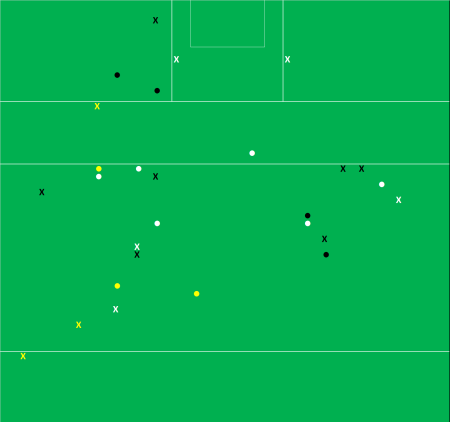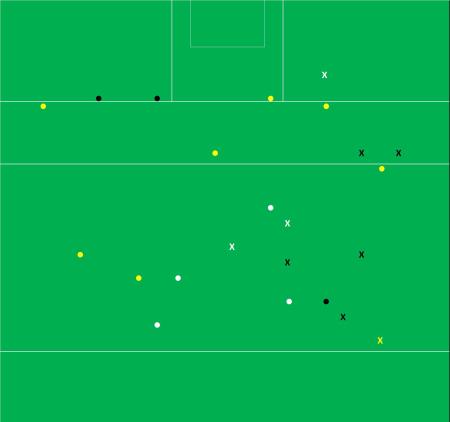The above table is split by halves however it can also be taken as a proxy for before/after the red card (in the 40th minute)
It highlights two aspects; firstly how utterly dominant Clann na nGael were post the red card but also, and probably more importantly, how this was no fluke as the platform had been laid in that opening 40 minutes when it was 15v15.
In those opening 40 minutes Clann na NGael had five more possessions and four more shots. Yes at the time of the red card there was only one point in it but that was due to excellent St. Brigids’ accuracy (83% Conversion Rate at that point with an Expt Pts of +3.57) more than anything else. Once the red card came the dam burst.
When Clann na nGael had the ball

Shot charts; disc = successful & “x” = unsuccessful. Yellow = deadball, red = attempt on goal, black = point attempt from play in the 1st half and white = point attempt from play in the 2nd half
… they were pretty devastating. 70% Conversion Rate and 0.68 points per possession are both excellent metrics. Every part of their attacking play was functioning but the game was cracked open with two goals in the 44th minute just after Brigids had levelled the game.
In total Clann had six shots at goal, with five different players having an attempt, returning 4 – 00 including the type of quick thinking from their sub Callinan for the 3rd goal (if anyone hasn’t seen it the clip is embedded here) which epitomised their all-round sharp display.
Scoring four goals means that to lose you either need to have a calamity on your remaining shooting or the opposition need to have an absolute worldly of a game. Neither happened here. Indeed the remainder of Clann’s shooting was as good as their shots at goal returning 69% (0 – 09 from 13; Expt pts +2.7) on point attempts which included two monsters from the two Shines. Donie Shine was also exemplary from deadballs scoring 0 – 06 from 8 on point attempts (including 0 – 02 from three 45s) as well as slotting a penalty. Indeed one of those misses was from the apex of the 20m line and sideline on the right with the right. Still not entirely convinced he was even going for a point with that looking at the angle!
Donie scoring 1 – 07 will rightly get the plaudits but he was ably supported on the attacking front by both Lennon & Fahy who combined for 1 – 05 from just 7 shots (86%; Expt Pts of +4.0). Apart from his shooting Fahy also had a quietly effective game as the link man providing three primary assists, setting up Dunning for the pivotal 2nd goal and winning a free for Shine to convert.
One aspect Clann may look at as they enter into the Connacht campaign was the fact that they got turned over six times outside the opposition’s 45. Brigids manufactured three shots and 0 – 02 from these six possessions but other teams will be more clinical.
When St. Brigids had the ball
In fairness to Brigids’ attacking unit they were also on point converting 87% (Expt Pts of +4.5). Their points per possession, in isolation, at 0.45 is very good. But the chasm between that and Clann’s 0.64, and the fact that they produced a lower return off an excellent Conversion Rate points to their deficiency; (a) they only scored one goal and (b) they just didn’t manufacture enough shots.
On the shot count; Brigids produced 12 fewer shots than Clann through a combination of having less possessions (33 to Clann’s 42) and a poorer Shot Rate (60% to Clann’s 82%).
They were in a hole to start with by having less possessions … they then dug further by not being able to convert those possessions they progressed into an attacking position into a shot.
Once they did pull the trigger they were every bit Clann’s equal with 71% (0 – 05 from 7; Expt Pts of +1.5) on point attempts, 1 – 01 from their two shots at goal and 100% (0 – 06 from 6) on their frees.
There just wasn’t enough shots
Senan Kilbride was very good early doors scoring 1 – 03 from 4 shots (including one free) in the first 15 minutes however the Clann defence got on top thereafter and he didn’t have another shot from play for the entire game.
A combination of the red card and Kilbride being marshalled saw Brigids attack being stifled to such an extent that they only produced two shots from play in the 2nd half
Kickouts
Clann na nGael absolutely destroyed Brigids on kickouts. The overall numbers show Clann na nGael gaining possession on 20 to Brigids 17 with the count being 12-10 on those that travelled past the 45. Nothing untoward there you might say but it was what came off the kickouts that was decisive.
Of the 20 kickouts they won Clann na Gael progressed 15 (75%) to a shot … Brigids manufactured seven shots off the 17 (41%) kickouts they won. Clann scored a barely creditable 3 – 09 directly off kickouts whilst only conceding 1 – 06.
























